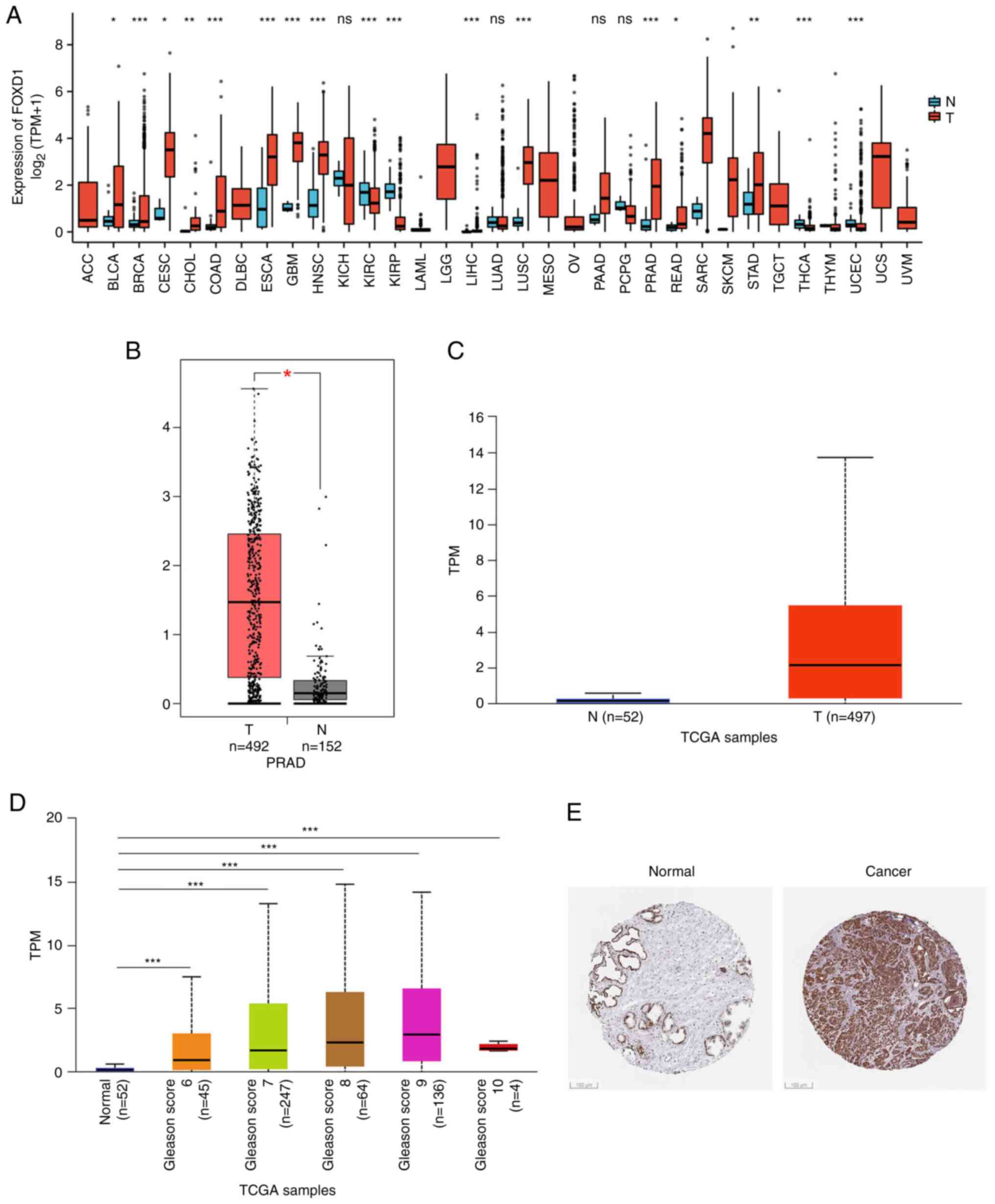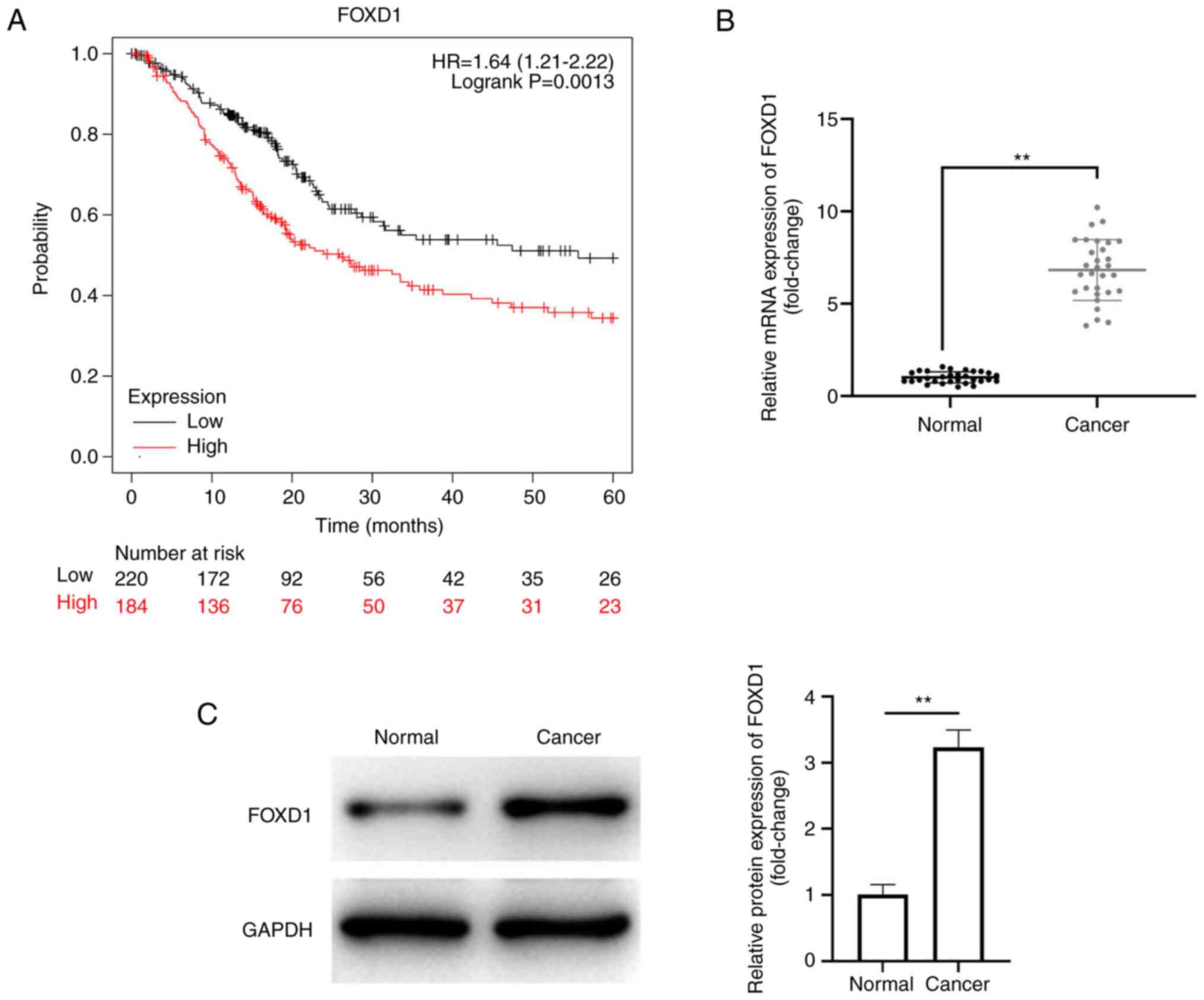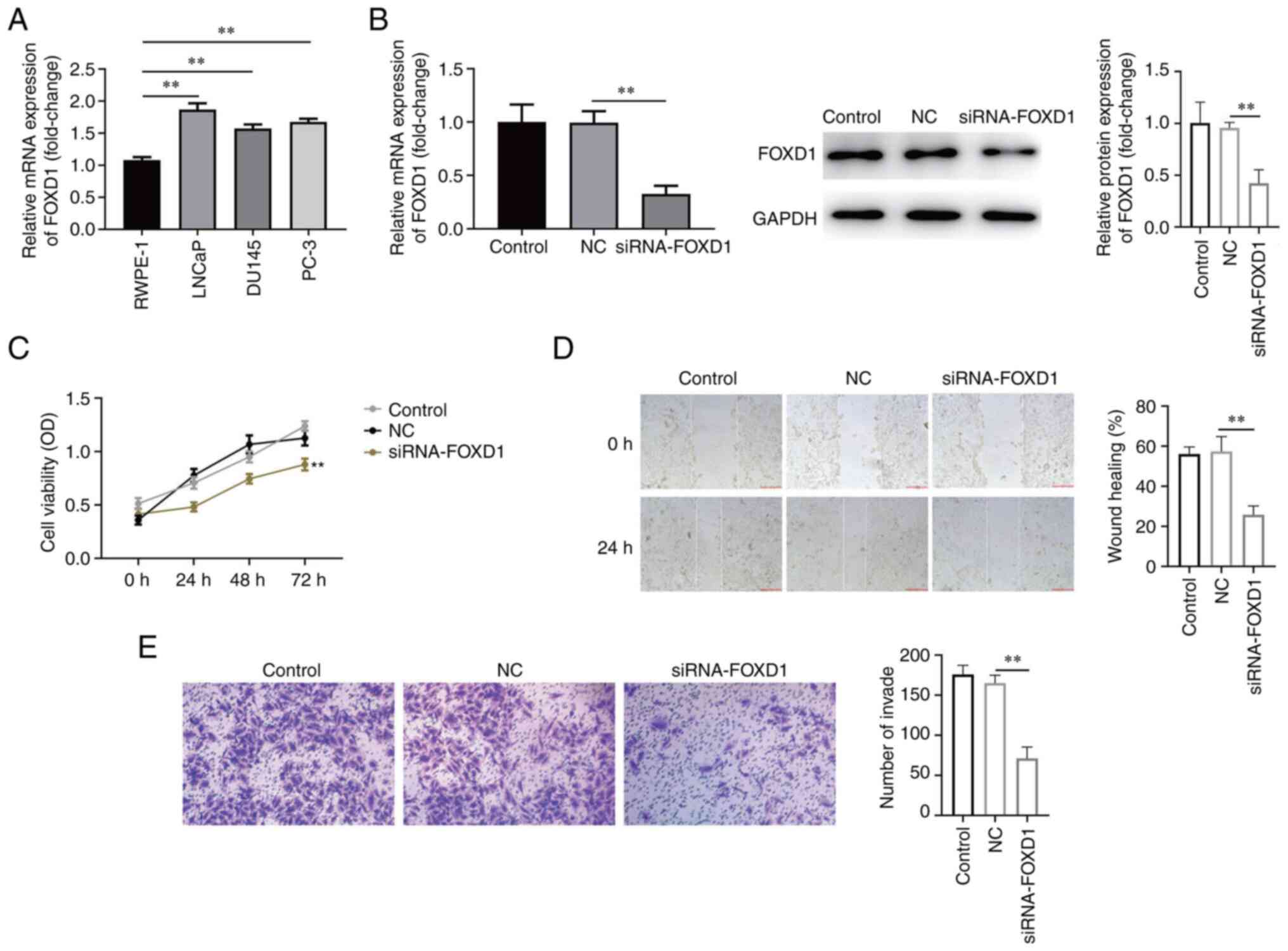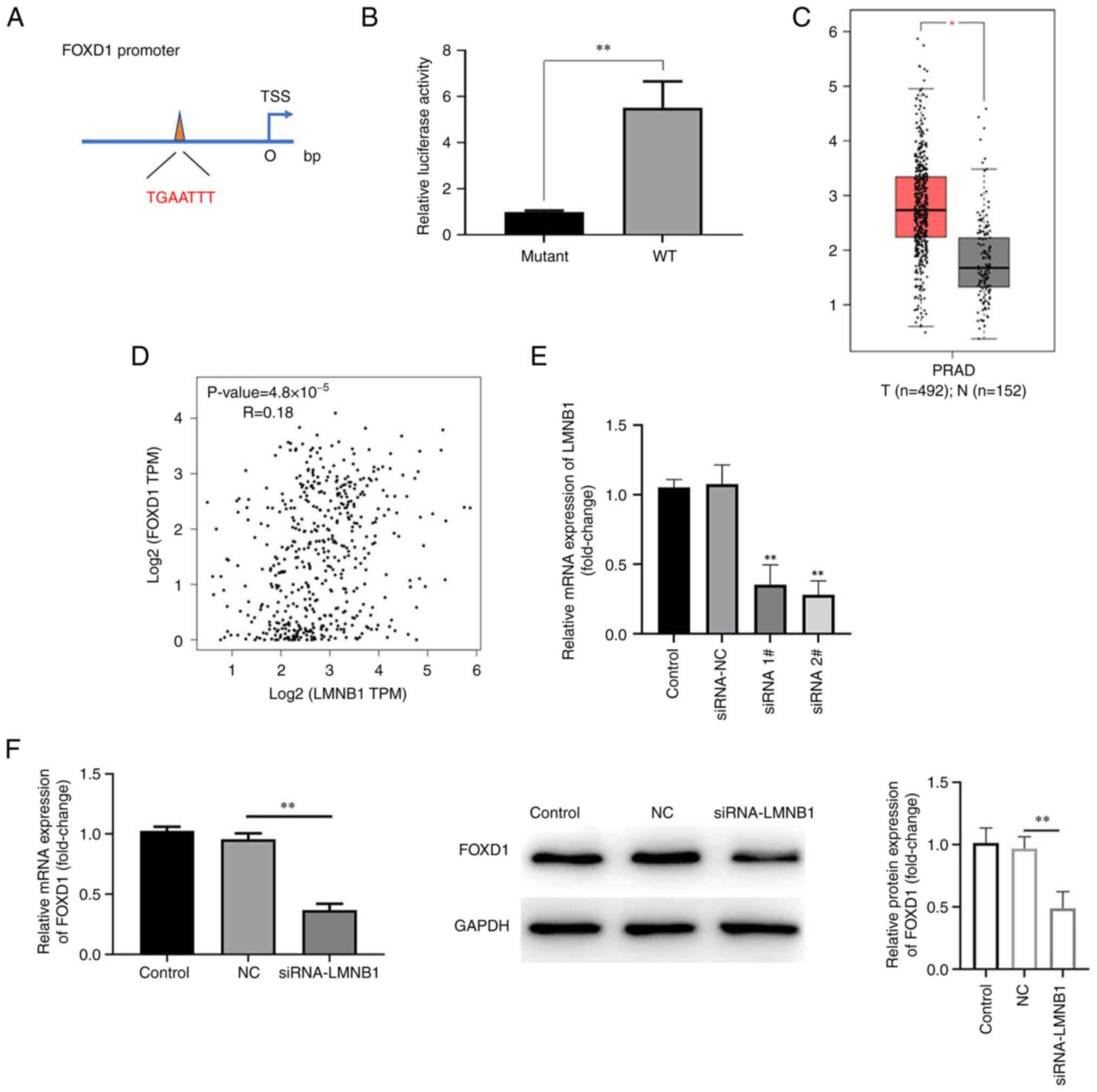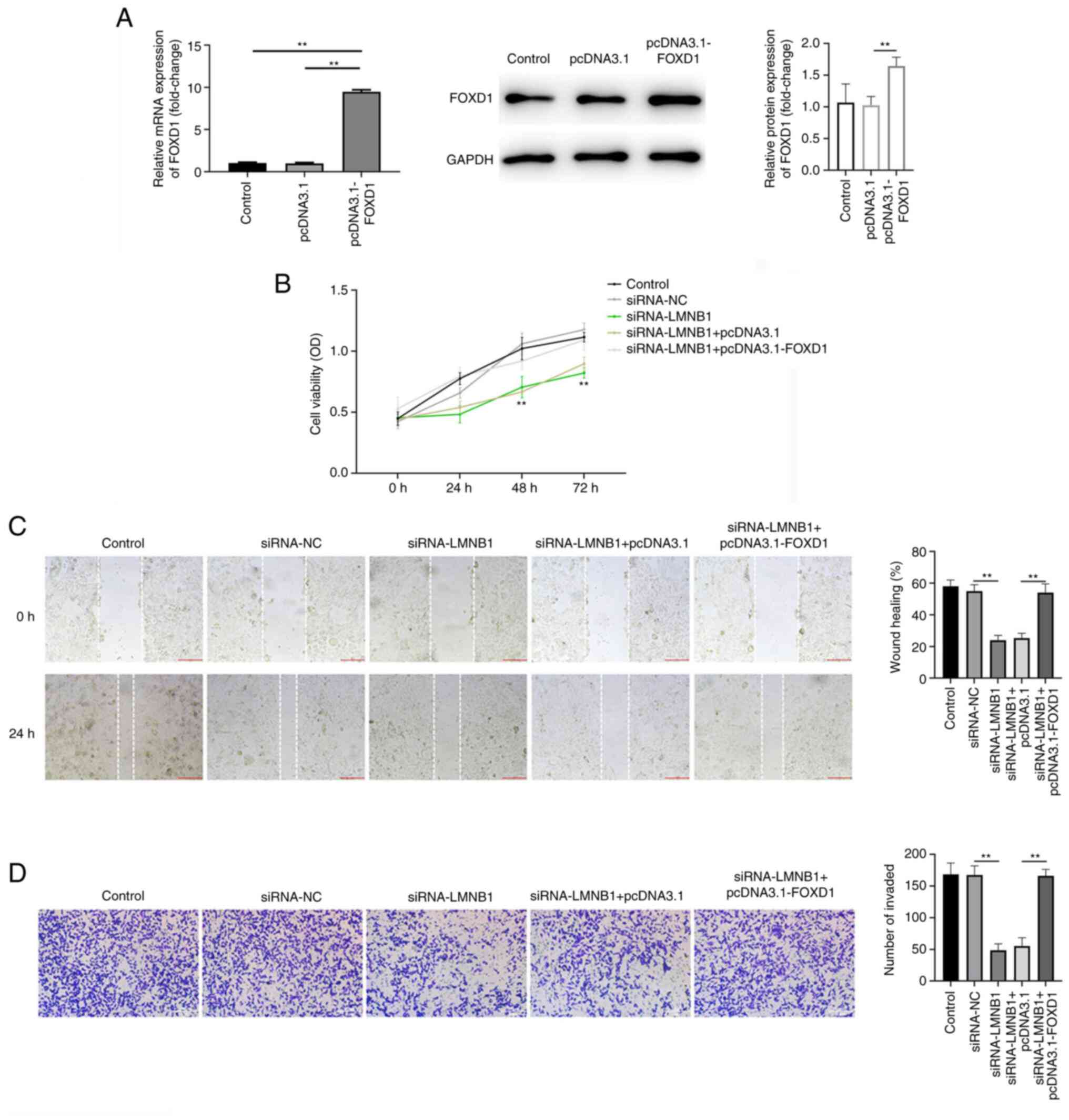LMNB1 targets FOXD1 to promote progression of prostate cancer
- Authors:
- Published online on: September 20, 2023 https://doi.org/10.3892/etm.2023.12212
- Article Number: 513
-
Copyright: © Huang et al. This is an open access article distributed under the terms of Creative Commons Attribution License.
Abstract
Introduction
Prostate cancer (PC) is one of the most common malignancies worldwide, affecting 1 in 9 male patients >65 years of age (1-3). At present, there is no effective treatment for advanced PC, which has led to it being the second leading cause of cancer-associated death in men (4). Therefore, identifying novel endogenous factors responsible for PC cell viability, migration and invasion will aid the understanding of the progression of PC and lead to the development of novel approaches for diagnosis and treatment.
The nuclear lamina, located in the inner layer of the nuclear membrane, is a protein network composed of numerous proteins, including lamins (3). One of the main roles of lamins is to maintain the physiological balance of cells (5). Lamin B1 (LMNB1) is a key B-type lamin protein that regulates cell apoptosis, signal transduction and other functions and serves an important role in the occurrence and development of tumors (6). Forkhead box D1 (FOXD1) belongs to the forkhead family transcription factor subfamily, which can active downstream target genes through transcription and participates in numerous biological activities, such as stem cell differentiation, organogenesis, cell cycle regulation and signal transduction (7). FOXD1 is a mediator of smooth cell reprogramming via self-renewal and differentiation (8). FOXD1 is associated with oncogenicity, tumor progression and metastasis in numerous types of carcinoma (9-11). FOXD1 expression has been reported to be upregulated in head and neck squamous cancer (12). FOXD1 is highly expressed in nasopharyngeal carcinoma and promotes cell malignancy (13). Fan et al (14) reported that FOXD1 expression is upregulated in laryngeal squamous cell carcinoma and promotes cell epithelial-to-mesenchymal transition by targeting zinc finger protein 532 expression. The aforementioned studies suggest that FOXD1 may function as a cancer-causing gene multiple cancer type. Jin et al (15) demonstrated that FOXD1 expression is upregulated in PR and that FOXD1 silencing reduces the expression of β-catenin and cyclin D1, which are involved in the Wnt/β-catenin signaling pathway. The present study aimed to identify the key functions of FOXD1 in PC and underlying mechanisms.
Materials and methods
Database analysis
The differential expression of FOXD1 in prostate cancer and adjacent tissues, as well as its expression in PC tissues at different stages, was analyzed by the Cancer Genome Atlas (TCGA) database from the University of ALabama at Birmingham CANcer data analysis Portal (UCLCAN) database (https://ualcan.path.uab.edu/cgi-bin/ualcan-res.pl). Expression of FOXD1 in PC and para-cancer tissue was assessed. Gene Expression Profiling Interactive Analysis (GEPIA) database (gepia.cancer-pku.cn/) is an interactive web server developed by Peking University that was used to analyze the differential expression of associated genes and their association with the survival prognosis of patients with prostate cancer. The Human Protein Atlas (HPA) database (proteinatlas.org/) provided data on FOXD1 protein expression in PC tissues (16). Kaplan-Meier Plotter (kmplot.com/analysis/) was used to analyze the association between FOXD1 expression and prognosis in PC. The clinical patient data was from Xiantao (https://www.xiantaozi.com/). The most commonly used staging for prostate cancer is TNM staging. TNM staging involves three stages for all prostate cancer, where T refers to the in situ tumor and describes the extent of the in situ tumor; N refers to regional lymph nodes, describing whether there is metastasis in the regional lymph nodes; M refers to distant metastasis. The binding between LMNB1 and FOXD1 was predicated by Human Tiny Flash Database (TFDB) (http://bioinfo.life.hust.edu.cn/AnimalTFDB/#!/). Expression of FOXD1 in normal prostate and PC tissues, the expression difference of FOXD1 in different grades of PC tissues, and its association with the survival prognosis of patients with PC were assessed.
Cell culture
RWPE-1 normal immortalized human prostate epithelial cells and DU145, PC-3 and LNCaP prostate cancer cells (Shanghai Institute of Cell Biology) were maintained in DMEM (Nanjing Biochannel Biotechnology Co., Ltd.) with 10% FBS (Nanjing Biochannel Biotechnology Co., Ltd.) at 37˚C with 5% CO2.
Cell transfection and treatment
FOXD1 overexpression vector (pcDNA3.1-FOXD1), small interfering RNA (siRNA)-LMNB1 and siRNA negative control (NC) were synthesized by Nanjing Genscript Biotechnology Co., Ltd. The sense and antisense strands for each siRNA were as follows: siRNA-FOXD1, 5'-TCGCCGAGCTCTGTTCTTAGACTCT-3'; siRNA1-LMNB1, 5'-TCCCGCGTGCGTGTGTGAGTGGGTG-3'; siRNA2-LMNB1, 5'-GGGCAAGTTAGGTTTGCTAGCTGCT-3'; and siRNA negative control (NC), 5'-UUCUCCGAACGUGUCUTT-3'. The siRNA-FOXD1 (500 ng/µl) and siRNA-LMNB1 (500 ng/µl) was transfected into prostate cancer cells for 48 h at 37˚C using Lipofectamine 3000 (Invitrogen; Thermo Fisher Scientific, Inc.) according to the manufacturer's instructions. Cells were collected 48 h after transfection. The efficiency of transfection was analyzed using reverse transcription-quantitative PCR (RT-qPCR).
RT-qPCR analysis
Total RNA of cells was extracted using TRIzol (Thermo Fisher Scientific, Inc.) according to the manufacturer's protocol. A total of 2 µl cDNA was synthesized from 2 ng total RNA with a RT Toolkit (Promega Corporation) according to the manufacturer's protocol. RT-qPCR was performed using a SYBR® Premix Ex Taq™ (Takara Bio, Inc.). Thermocycling conditions were as follows: Initial denaturation for 10 min at 95˚C, followed by 35 cycles of 95˚C for 5 sec and 72˚C for 30 sec. The 2-ΔΔCq method (17) was used to calculate relative gene expression. GAPDH was used to normalize RNA expression. The primer sequences were as follows: FOXD1 forward, 5'-TGAGCACTGAGATGTCCGATG-3' and reverse, 5'-CACCACGTCGATGTCTGTTTC-3'; LMNB1 forward, 5'-AAGCAGCTGGAGTGGTTGTT-3' and reverse, 5'-TTGGATGCTCTTGGGGTTC-3'; and GAPDH forward, 5'-CCCATGTTCGTCATGGGTGT-3' and reverse, 5'-TGGTCATGAGTCCTTCCACGATA-3'.
Cell proliferation analysis
Cell proliferation was determined using Cell Counting Kit-8 (CCK-8; Beyotime Institute of Biotechnology). Briefly, 2x104 cells/well were seeded in 96-well plates for 24 h and transiently transfected with siRNA-FOXD1, as aforementioned. A total of 10 µl CCK-8/well was added at 0, 1, 2, 3 and 4 days post-transfection. The plates were cultured at 37˚C for 2 h. The absorbance at 450 nm was measured using a microplate reader.
Luciferase reporter assay
Luciferase reporter assay was used to detect the association between FOXD1 and LMNB1. FOXD1 promoter region fragment containing the potential binding site of LMNB1 was amplified by PCR and cloned into the pGL3-basic vector (Promega Corporation), as were the wild-type/mutant sequences (WT/Mut). The PCR was performed using the following sequences: Forward, GTGTGGTTGGGACTCACGTCGCTTTC and reverse, TAGCAGAAGGGGGCCTGTCACATGG (Nanjing Genscript Biotechnology Co., Ltd.). Next, the pGL3-basic vector or pGL3-LMNB1 (Shanghai GenePharma Co., Ltd.) and luciferase reporter vectors were co-transfected into 293 cells using Lipofectamine 3000 (Invitrogen; Thermo Fisher Scientific, Inc.). A luciferase reporter assay kit (cat. no. E1910; Promega Corporation) was used for the luciferase activity measurement 48 h after transfection. Firefly fluorescence intensity was calculated using Renilla luciferase activity for normalization.
Western blot analysis
RIPA Lysis Buffer (Beyotime Institute of Biotechnology) was used to extract total proteins from prostate cancer tissue and cell samples, and a BCA kit (Beyotime Institute of Biotechnology) was used to detect the concentration. An equal quantity of proteins (30 µg) was added in each lane of a 10% SDS-PAGE gel. Membrane Blocking Solution (MilliporeSigma) was used to block the PVDF membranes with transferred proteins for 1 h at room temperature. Membranes were incubated with primary antibodies against FOXD1 (1:1,000; cat. no. sc-293238), E-cadherin (1:1,000; cat. no. sc-8426), N-cadherin (1:1,000; cat. no. sc-8424), Vimentin (1:1,000; cat. no. sc-6260) and GAPDH (1:2,000; cat. no. sc-47724) (all Santa Cruz Biotechnology, Inc.) overnight at 4˚C. Subsequently, membranes were incubated with horseradish peroxidase-conjugated secondary antibody (1:5,000; cat. no. sc-2357; Santa Cruz Biotechnology, Inc.) at room temperature for 2 h before ECL detection using BeyoECL Plus kit (Beyotime Institute of Biotechnology). ImageJ software (version 1.53; National Institutes of Health) was used to analyze density of immune blots. GAPDH acted as the internal reference protein.
Transwell assay
A total of 3x104 cells were added to serum-free DMEM and placed in the upper layer of the Transwell chamber (Corning, Inc.) that had been precoated with Matrigel at room temperature for 1 h. A total of 600 µl DMEM, including 20% FBS (Nanjing Biochannel Biotechnology Co., Ltd.), was placed in the bottom layer at 37˚C. Following 24 h of incubation, 4% paraformaldehyde was used for 20 min to fix the cells that had invaded the bottom layer at room temperature. Subsequently, cells were stained with crystal violet for 20 min at room temperature. Cells were counted manually under a light microscope (Olympus Corporation) in five randomly selected fields of view/sample.
Wound healing assay
LNCaP cells in logarithmic growth phase (when the cell density reached ≥90%) were inoculated into the 6-well plate. For LNCaP cells in the control, NC, siRNA-FOXD1, siRNA-LMNB1, siRNA-LMNB1 + pcDNA 3.1 and siRNA-LMNB1 + pcDNA 3.1-FOXD1 groups, lines were drawn horizontally using a 200-µl pipette tip at the bottom of the culture plate for reference. When cells were attached to the surface of the plate, the DMEM (Nanjing Biochannel Biotechnology Co., Ltd.) was replaced with fresh medium containing 1% FBS (Nanjing Biochannel Biotechnology Co., Ltd.). After 48 h at 37˚C, scratch width was imaged by a light microscope (Olympus Corporation) observed to calculate wound healing rate as follows: (Wound width at 0 h-wound width at 48 h)/wound width at 0 h x100.
Statistical analysis
All experimental results from three independent experiments were analyzed using GraphPad software (version 5.0; GraphPad Software, Inc.; Dotmatics). All data are presented as the mean ± SD. Student's t-test was used for comparisons between two groups and one-way analysis of variance was used for comparisons among multiple groups. The receiver operating characteristic (ROC) curve was compared by log-rank test. P<0.05 was considered to indicate a statistically significant difference.
Results
FOXD1 is upregulated in PC and associated with adverse prognosis
Tumor samples from TCGA were analyzed to characterize FOXD1 expression (Fig. 1A). FOXD1 was upregulated in numerous types of cancer. Subsequently, FOXD1 expression in PC was assessed based on the GEPIA2 (Fig. 1B) and TCGA (Fig. 1C) databases. FOXD1 expression was significantly upregulated in PC samples. Furthermore, analysis of the association between FOXD1 and histological grading of patients with PC was performed. FOXD1 expression was positively associated with the Gleason score of the patients with PC (Fig. 1D). Additionally, the protein expression of PC based on the HPA database confirmed the abnormally high expression of FOXD1 in PC tissue (Fig. 1E).
The present study evaluated the relationship between FOXD1 and prognosis in PC. FOXD1 expression was an independent prognostic factor for TNM classification (Table I). Patients with low FOXD1 expression exhibited a markedly higher probability of survival at all time points analyzed (Fig. 2A). Also, relative mRNA expression level of FOXD1 in PC tissue was significantly higher than that in normal tissue (Fig. 2B). Meanwhile, relative protein expression of FOXD1 in PC tissue was significantly higher than that in PC tissues (Fig. 2C). These results supported the oncogenic role of FOXD1 in PC progression.
FOXD1 knockdown inhibits PC cell viability, migration and invasion
FOXD1 expression in PC cell lines was detected by western blotting. FOXD1 expression was upregulated in all PC cell lines; LNCaP cells, which exhibited the highest expression levels, were selected for subsequent experiments (Fig. 3A). siRNA-FOXD1 markedly inhibited FOXD1 mRNA and protein expression (Fig. 3B). The result of CCK-8 analysis indicated a significant decrease in the viability of LNCaP cells in which FOXD1 was knocked down (Fig. 3C). The results of wound healing and Transwell assays revealed that the knockdown of FOXD1 significantly inhibited LNCaP cell migration and invasion (Fig. 3D and E). These results demonstrated that knockdown of FOXD1 inhibited LNCaP cell viability, invasion and migration.
LMNB1 is positively associated with FOXD1
HumanTFDB analysis revealed that LMNB1 targets FOXD1 mRNA (positions 1,128-1,143; Fig. 4A). The luciferase activity was significantly elevated in cells co-transfected with LMNB1 WT compared with Mut, indicating binding between FOXD1 and LMNB1 (Fig. 4B). Subsequently, the present study analyzed TCGA database and revealed that LMNB1 was highly expressed in patients with prostate adenocarcinoma (Fig. 4C). Additionally, the GEPIA database was used to characterize the association between FOXD1 and LMNB1, which demonstrated a positive association between them (Fig. 4D). RT-qPCR was used to detect transfection efficiency of the siRNAs. mRNA expression of LMNB1 was downregulated in both siRNA 1# and siRNA 2# groups and mRNA expression of LMNB1 in siRNA 2# was lower than that in siRNA 1# group. Therefore, siRNA 2# was selected for subsequent experiments (Fig. 4E). Next, western blotting was used to detect the LMNB1 protein levels after knockdown of FOXD1. The results indicated decreased LMNB1 expression following transfection of siRNA-FOXD1 (Fig. 4F).
LMNB1 acts directly on FOXD1 to mediate PC malignant progression
To clarify the mechanism of the influence of LMNB1 on PC cell progression, LNCaP cells were transfected with pcDNA3.1 and pcDNA3.1-FOXD1. RT-qPCR and western blotting demonstrated that pcDNA3.1-FOXD1 was successfully transfected (Fig. 5A). CCK-8 assay revealed that siRNA-LMNB1 notably decreased cell viability compared with the control group, while FOXD1 overexpression counteracted this effect (Fig. 5B). Similarly, knockdown of LMNB1 significantly inhibited cell migration and invasion, and these effects were reversed by FOXD1 overexpression (Fig. 5C and D).
Discussion
The present study investigated the effect of FOXD1 in the occurrence and development of PC and its possible mechanisms. Utilizing TCGA, the present study demonstrated that FOXD1 mRNA expression was higher in PC than normal tissues and its abnormally high expression was associated with poor prognosis. In vitro experiments revealed that FOXD1 knockdown markedly inhibited viability and invasion of PC cells. LMNB1 targeted FOXD1 and mediated the PC malignant progression. These findings highlighted that LMNB1 targeted regulation of FOXD1 to promote the occurrence and development of PC.
The FOX family is a key complex family of genes that includes a variety of cell- and tissue-specific ‘wing helix’ transcription factors (18). FOXD1, a newly identified FOX family transcription factor, serves as an oncogene in multiple types of cancer (19-21). For example, Sun et al (19) indicated that FOXD1 promoted progression of metastatic melanoma by regulating CTGF expression. Zong et al (20) suggested that FOXD1 was a biomarker of colorectal cancer, and Li et al (21) revealed that FOXD1 was associated with the development of primary oral squamous cell carcinoma.
Current studies showed that the expression of FOXD1 was upregulated in PC (22,23). Furthermore, the present study analyzed the association between abnormal FOXD1 expression and PC grade and prognosis using bioinformatics. Further experiments using PC cell lines revealed that FOXD1 expression was aberrantly high in PC cells, as expected. Additionally, knockdown of FOXD1 markedly inhibited PC cell viability, migration and invasion.
To determine the potential molecular mechanism of LMNB1, the present study predicted its possible target, FOXD1. LMNB1 is a protein component of the nucleoskeleton (24). LMNB1 possesses numerous biological functions. In addition to maintaining shape and integrity of the nucleus, LMNB1 regulates cell proliferation and senescence, DNA replication and gene expression, DNA damage repair and chromosome distribution and aggregation (25,26). Additionally, LMNB1 is associated with the development of neurological disease and tumors (27,28). Previous studies and network analyses have demonstrated the biomarker utility of LMNB1 in human cancer (7). To the best of our knowledge, the only recent report states that LMNB1 upregulation is associated with cancer metastasis and adverse survival outcomes in patients with primary PC (28). Furthermore, the present results indicated that LMNB1 positively regulated FOXD1. The effects of knockdown of LMNB1 on PC cells were reversed by FOXD1 overexpression.
In conclusion, the present study provided evidence that FOXD1 is key in malignant progression of PC. The function may be positively regulated through LMNB1. However, the number of clinical samples in the present study was small and further research is required.
Acknowledgements
Not applicable.
Funding
Funding: This study was supported in part by grants from the Guizhou Province Department of Education Project [grant no. QJH KY (2020) 063] and the Anshun University/Innovation Center for Efficient Agricultural of Guizhou Mountain Characteristics/Branch of learning in Agricultural Resources and Environment.
Availability of data and materials
The datasets used and/or analyzed during the current study are available from the corresponding author on reasonable request.
Authors' contributions
YH contributed to the conception of the study, performed the data analyses and wrote the manuscript. LZ performed the experiments. TL and EL contributed significantly to data analysis and manuscript preparation. All the authors have read and approved the final manuscript. YH, LZ, TL and EL confirm the authenticity of all the raw data.
Ethics approval and consent to participate
Not applicable.
Patient consent for publication
Not applicable.
Competing interests
The authors declare that they have no competing interests.
References
|
Pernar CH, Ebot EM, Wilson KM and Mucci LA: The epidemiology of prostate cancer. Cold Spring Harb Perspect Med. 8(a030361)2018.PubMed/NCBI View Article : Google Scholar | |
|
Catalona WJ: Prostate cancer screening. Med Clin North Am. 102:199–214. 2018.PubMed/NCBI View Article : Google Scholar | |
|
Boyle HJ, Alibhai S, Decoster L, Efstathiou E, Fizazi K, Mottet N, Oudard S, Payne H, Prentice M, Puts M, et al: Updated recommendations of the international society of geriatric oncology on prostate cancer management in older patients. Eur J Cancer. 116:116–136. 2019.PubMed/NCBI View Article : Google Scholar | |
|
Swami U, McFarland TR, Nussenzveig R and Agarwal N: Advanced prostate cancer: Treatment advances and future directions. Trends Cancer. 6:702–715. 2020.PubMed/NCBI View Article : Google Scholar | |
|
Charar C and Gruenbaum Y: Lamins and metabolism. Clin Sci (Lond). 131:105–111. 2017.PubMed/NCBI View Article : Google Scholar | |
|
Qin H, Lu Y, Du L, Shi J, Yin H, Jiang B, Chen W, Diao W, Ding M, Cao W, et al: Pan-cancer analysis identifies LMNB1 as a target to redress Th1/Th2 imbalance and enhance PARP inhibitor response in human cancers. Cancer Cell Int. 22(101)2022.PubMed/NCBI View Article : Google Scholar | |
|
Golson ML and Kaestner KH: Fox transcription factors: From development to disease. Development. 143:4558–4570. 2016.PubMed/NCBI View Article : Google Scholar | |
|
Koga M, Matsuda M, Kawamura T, Sogo T, Shigeno A, Nishida E and Ebisuya M: Foxd1 is a mediator and indicator of the cell reprogramming process. Nat Commun. 5(3197)2014.PubMed/NCBI View Article : Google Scholar | |
|
Chen C, Xu ZQ, Zong YP, Ou BC, Shen XH, Feng H, Zheng MH, Zhao JK and Lu AG: CXCL5 induces tumor angiogenesis via enhancing the expression of FOXD1 mediated by the AKT/NF-κB pathway in colorectal cancer. Cell Death Dis. 10(178)2019.PubMed/NCBI View Article : Google Scholar | |
|
Gao YF, Liu JY, Mao XY, He ZW, Zhu T, Wang ZB, Li X, Yin JY, Zhang W, Zhou HH and Liu ZQ: LncRNA FOXD1-AS1 acts as a potential oncogenic biomarker in glioma. CNS Neurosci Ther. 26:66–75. 2020.PubMed/NCBI View Article : Google Scholar | |
|
Li D, Fan S, Yu F, Zhu X, Song Y, Ye M, Fan L and Lv Z: FOXD1 promotes cell growth and metastasis by activation of vimentin in NSCLC. Cell Physiol Biochem. 51:2716–2731. 2018.PubMed/NCBI View Article : Google Scholar | |
|
Huang J, Liang B and Wang T: FOXD1 expression in head and neck squamous carcinoma: A study based on TCGA, GEO and meta-analysis. Biosci Rep. 41(BSR20210158)2021.PubMed/NCBI View Article : Google Scholar | |
|
Ren D, Lu J, Han X, Xiong W, Jiang H, Wei Y and Wang Y: LINC00641 contributes to nasopharyngeal carcinoma cell malignancy through FOXD1 upregulation at the post-transcriptional level. Biochem Cell Biol. 99:750–758. 2021.PubMed/NCBI View Article : Google Scholar | |
|
Fan L, Wang J, Deng P, Wang Y, Zhang A, Yang M and Zeng G: Foxhead box D1 promotes the partial epithelial-to-mesenchymal transition of laryngeal squamous cell carcinoma cells via transcriptionally activating the expression of zinc finger protein 532. Bioengineered. 13:3057–3069. 2022.PubMed/NCBI View Article : Google Scholar | |
|
Jin Y, Liang Z and Lou H: The emerging roles of fox family transcription factors in chromosome replication, organization, and genome stability. Cells. 9(258)2020.PubMed/NCBI View Article : Google Scholar | |
|
Uhlén M, Fagerberg L, Hallström BM, Lindskog C, Oksvold P, Mardinoglu A, Sivertsson Å, Kampf C, Sjöstedt E, Asplund A, et al: Proteomics. Tissue-based map of the human proteome. Science. 347(1260419)2015.PubMed/NCBI View Article : Google Scholar | |
|
Livak KJ and Schmittgen TD: Analysis of relative gene expression data using real-time quantitative PCR and the 2(-Delta Delta C(T)) method. Methods. 25:402–408. 2001.PubMed/NCBI View Article : Google Scholar | |
|
Quintero-Ronderos P and Laissue P: The multisystemic functions of FOXD1 in development and disease. J Mol Med (Berl). 96:725–739. 2018.PubMed/NCBI View Article : Google Scholar | |
|
Sun Q, Novak D, Hüser L, Poelchen J, Wu H, Granados K, Federico A, Liu K, Steinfass T, Vierthaler M, et al: FOXD1 promotes dedifferentiation and targeted therapy resistance in melanoma by regulating the expression of connective tissue growth factor. Int J Cancer. 149:657–674. 2021.PubMed/NCBI View Article : Google Scholar | |
|
Zong Y, Miao Y, Li W, Zheng M, Xu Z, Gao H, Feng W, Xu Z, Zhao J, Shen L and Lu A: Combination of FOXD1 and Plk2: A novel biomarker for predicting unfavourable prognosis of colorectal cancer. J Cell Mol Med. 26:3471–3482. 2022.PubMed/NCBI View Article : Google Scholar | |
|
Li Z, Yan T, Wu X, Zhang W, Li J, Wang L and Yang J: Increased expression of FOXD1 is associated with cervical node metastasis and unfavorable prognosis in oral squamous cell carcinoma. J Oral Pathol Med. 49:1030–1036. 2020.PubMed/NCBI View Article : Google Scholar | |
|
Cai K, Chen S, Zhu C, Li L, Yu C, He Z and Sun C: FOXD1 facilitates pancreatic cancer cell proliferation, invasion, and metastasis by regulating GLUT1-mediated aerobic glycolysis. Cell Death Dis. 13(765)2022.PubMed/NCBI View Article : Google Scholar | |
|
Donmez C and Konac E: Silencing effects of FOXD1 inhibit metastatic potentials of the PCa via N-cadherin-Wnt/β-catenin crosstalk. Gene. 836(146680)2022.PubMed/NCBI View Article : Google Scholar | |
|
Li J, Sun Z, Cui Y, Qin L, Wu F, Li Y, Du N and Li X: Knockdown of LMNB1 inhibits the proliferation of lung adenocarcinoma cells by inducing DNA damage and cell senescence. Front Oncol. 12(913740)2022.PubMed/NCBI View Article : Google Scholar | |
|
Saed L, Jeleń A, Mirowski M and Sałagacka-Kubiak A: Prognostic significance of HMGA1 expression in lung cancer based on bioinformatics analysis. Int J Mol Sci. 23(6933)2022.PubMed/NCBI View Article : Google Scholar | |
|
Evangelisti C, Rusciano I, Mongiorgi S, Ramazzotti G, Lattanzi G, Manzoli L, Cocco L and Ratti S: The wide and growing range of lamin B-related diseases: From laminopathies to cancer. Cell Mol Life Sci. 79(126)2022.PubMed/NCBI View Article : Google Scholar | |
|
Luo F, Han J, Chen Y, Yang K, Zhang Z and Li J: Lamin B1 promotes tumor progression and metastasis in primary prostate cancer patients. Future Oncol. 17:663–673. 2021.PubMed/NCBI View Article : Google Scholar | |
|
Hua Y, He Z and Zhang X: A pan-cancer analysis based on weighted gene co-expression network analysis identifies the biomarker utility of lamin B1 in human tumors. Cancer Biomark. 34:23–39. 2022.PubMed/NCBI View Article : Google Scholar |



